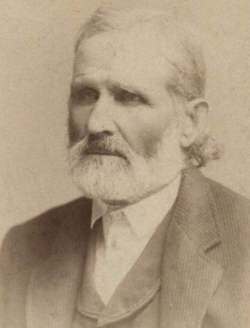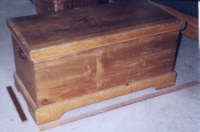![]()
 Adams Davenport, c. 1890 |
Adams was born to Enos
and Phoebe Davenport about 1830. When news of the
discovery of gold at Sutter's Mill reached the East in
1849 Adams decided to head west and seek his fortune. As part of his preparations for the journey he built a small cedar trunk to hold his clothes and a few possessions. |
|
| Adams boarded ship in New York for Panama,
but contracted malaria upon his arrival there. He hired
two natives to make the crossing of the Isthmus, one was
to carry him, one was to carry this trunk. When he
reached the Pacific side of the Isthmus he again boarded
a ship, now bound for San Francisco. To cure himself of
the malaria he laid out on the deck of the ship in the
sunshine and drank whiskey. This unusual remedy worked, but left him somewhat weak. He decided that life in the gold fields was too risky and stayed in San Francisco to ply his trade as a carpenter instead. To keep people from running off to the gold fields, they paid very high wages and Adams did rather well. In about 1851, when the time came to return home, he travelled across what is now the United States by wagon train, bringing with him a small fortune in gold, saved from his wages. There were three known artifacts of his journey in the family. One is a gold nugget as big as your thumb that was his watch fob, the second was a three legged frying pan used on the wagon train trip and the third was this trunk. I'm not exactly sure where the other two items are, but below are some photographs of the trunk for those who might be interested. Upon his arrival home, Adams purchased a grist mill in the little village of Millbrook, near Dover, N.J., just off present day Rt. 10. There he married and raised a family, a long tale for another day. Adams was known far and wide as "The Honest Miller," something of note in those days. The rumors of his gold stash circulated though and upon his death in 1908 many searched for it. My grandmother, who was his granddaughter, cared for him in his old age. She always said she thought he'd used the gold as his pension fund. After his death the trunk sat in the farmhouse at Mt. Fern and has since been passed down through the family as a treasured heirloom. Adams left no written records of his journey and one wonders what tales this trunk could tell. I hope you enjoy these photographs of it. Click on an image for
a larger version. Use your browser's back button to
return here. |
||
 |
 |
 |
 |
 |
 |
For those who might like to reproduce this trunk, some details: The outside dimensions are 31 inches l-r by 15 inches high by 14 inches front to back. The upper trim band is 2 inches wide and 9/16 inches thick. The lower trim band is 3 3/8 inches wide and 9/16 inches thick. You can see from the photos how these trim bands are beaded. Those facing out on the sides are 1/2 inch wide, the one on the top is 1/4 inch wide. The cutouts on the bottom trim band are 1 1/2 inches high and begin five inches from the corner on the front, four inches on the sides. The curves are not a simple radius cut, but appear to be "eased" so that the cut rises sharply at first and then flows into the horizontal dimension more gently. You can see in image #4 above how this looks close up. The pencil marks you see are original. Along the vertical edge you can see where he scored the wood to make a mark for the joint. I believe the trunk might have been painted in the interim but is bare wood now and has a very soft, smooth patina. The sides and top are all made out of a single width of board, 3/4 inch thick and planed smooth. The small "pocket" is 4 inches square on the inside. The side and bottom sit loosely in dados chiselled out of the body of the trunk, made of 9/16 inch clear stock. My grandfather, a builder on another side of the family, identified the wood as south Jersey cedar. I hope to make detailed measured drawings at some point but these measurements are fairly easily interpreted to make your own working plans, based on the images above. I don't believe the handles on the sides are original, but the hinges appear to be. The lock is missing but the original catch is still there, hand forged apparently. Please feel free to email me if you have specific questions. I've seen from reports of similar trunks that the "pocket" in the inside could be made with a double bottom. The side was left loose in it's dado to slide up and give access to a "secret compartment." I've looked close and there's none here, but it would be an interesting variation for historical interpretive purposes. Please let me know if you make a reproduction of the trunk, I'd be pleased to post a photograph of yourself and the finished product here. |
||